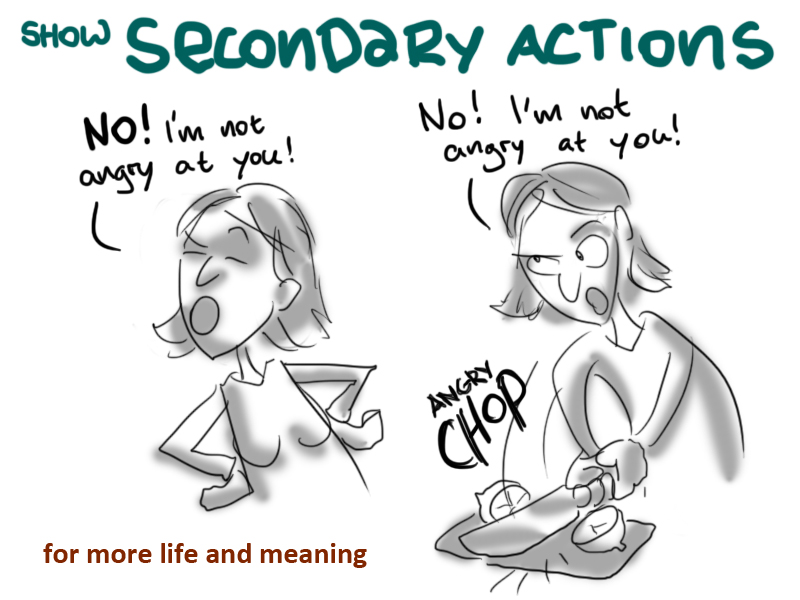Squash and Stretch
The most important thing is "Squash and Stretch", the purpose of which is to give a
sense of weight and flexibility to drawn objects, this prepares the audience for the action that is about to happen.

An example of what squash and stretch can do.

An example of what squash and stretch can do.
Anticipation
Anticipation is used to prepare the audience for an action , and to make the action appear more realistic.

Showing an example of 'anticipation', showing the different actions of bugs bunny throwing a punch at a bull dog.

Showing an example of 'anticipation', showing the different actions of bugs bunny throwing a punch at a bull dog.
Staging
This principle is parallel to staging as it is known in theater and film . Its purpose is to direct the audience's attention, and make it clear what is of greatest importance in a scene. whether it is an action, expression or mood. This can be the placement
of the character within the frame, the use of light and shadow or the
angle of the camera.
 an example of staging from the film 'ratatouille'
an example of staging from the film 'ratatouille'
 an example of staging from the film 'ratatouille'
an example of staging from the film 'ratatouille'
Straight ahead action and pose to pose
These are two different approaches to the actual drawing process. "straight ahead action" means drawing out a scene frame from beginning to end , while "pose to pose" involves starting with drawing a few key frames, and then filling in the intervals later. "straight ahead action" creates a more fluid , dynamic illusion of movement, and is better for producing realistic action sequences.

An example of what 'straight ahead action and pose to pose' does.

An example of what 'straight ahead action and pose to pose' does.
Follow through and overlapping action
Helps to render movement more realistically, and help to give the impression that characters follow the laws of physics. "follow through means that separate parts of a body will continue moving after the character has stopped. "overlapping action" is the tendency for parts of the body to move at different rates.

An example of 'follow through and overlapping action'.

An example of 'follow through and overlapping action'.
Slow in and Slow out
The movement of the human body , and most other objects, needs time to accelerate and slow down. for this reason, animation looks more realistic if it has more drawings near the beginning and end of an action, emphasizing the extreme poses, and fewer in the middle. this principle goes for characters moving between two extreme poses, such as sitting down and standing up, but also for inanimate, moving objects, like the bouncing ball.


An example of 'slow in and slow out'.
Arcs
Arcs
Most natural action tends to follow an arched path , and animation should stick to this principle by following implied "arcs" for greater realism. This can apply to a limb moving by rotating a joint, or a thrown object moving along a parabolic path. the exception is mechanical movement, which typically moves straight lines.


An example of what you can do with an arc, shown(on top) on the guys wrist's
Secondary action
Secondary action
Main actions added by secondary actions give a scene more life, and can help to support the main action.


An example of secondary action which helps support its main action.
Timing
Timing
Timing refers to the number of drawings or frames for a given action, which translates to the speed of the action on film.


An example of 'timing', using the bouncing ball and with each keyframe you draw out the ball and once it bounces once , it starts to get lower and lower, lesser key-frames to lesser key-frames, all to bring out the realism.
Exaggeration
Exaggeration
Is a effect especially useful for animation, as perfect imitation of reality can look static and dull in cartoons.


An example of exaggeration,(were you make your character or scenes over the top in everything)
Solid Drawing
Solid Drawing
The principle of solid drawing means taking into account forms in three-dimensional space, giving them volume and weight. The animator needs to be a skilled drafter and has to understand the basics of 3D shapes, anatomy, weight, balance, light and shadow, etc. for classical animators , this means taking art classes and doing sketches for life.

An example of solid drawing of 'homer Simpson' and how he is measured and drawn out.

An example of solid drawing of 'homer Simpson' and how he is measured and drawn out.
Appeal
Appeal in a cartoon character corresponds to what would be called charisma in an actor.
An example of 'Appeal' from the character bugs bunny, who has that charisma in him.
No comments:
Post a Comment